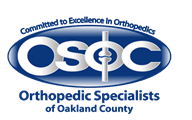|
|
Matt Bahu, MD St. Joseph Mercy Oakland |
The shoulder is one of the most commonly used joints in the body and can be affected with arthritis the same way that hips and knees commonly are.
The shoulder is composed of multiple joints. The glenohumeral
joint is the “ball and socket” portion of the shoulder and the most
clinically relevant part painfully affected by arthritis.
While anyone can develop arthritis, those that are middle-aged
and senior citizens are affected most. Shoulder arthritis, like most
other arthritic sites, can occur spontaneously, as a result of over-use
of the joint, or secondary to previous trauma, including fracture,
dislocation, or rotator cuff tear. However, there are three common
types of arthritis most commonly affecting the shoulder, including:
• Osteoarthritis
This type of arthritis commonly affects those age 50 and over. It
occurs due to over-use of the joint and is a degenerative condition
that will continue to break down the cartilage that covers and
protects the bone.
• Rheumatoid Arthritis
This type can affect anyone, regardless of age, and is a systematic
inflammatory condition, meaning that it often affects multiple
joints on either side of the body.
• Posttraumatic Arthritis/ Cuff Tear Arthritis
As the names suggest, these types of arthritis occur after trauma
or injury to the shoulder, including fractures, dislocations, or
secondary to massive, non-repairable rotator cuff tears.
Those suffering from arthritis may have feelings of heaviness, stiffness,
and chronic pain around the shoulder. Others with shoulder arthritis
experience a limited range of motion and also may hear a clicking
or popping noise when they rotate the joint. Many patients also
experience increased pain or stiffness in the morning.
After undergoing a routine physical exam, your physician may
request that you have X-rays or an MRI in order to properly
diagnose and characterize arthritis of the shoulder. You may then
be referred to a shoulder specialist.
Treatments
Depending on the severity of the arthritis, most physicians will
suggest non-surgical methods as the first line of treatment. Some
steps that your physician may start with include: resting the joint,
applying heat, physical therapy, or taking an anti-inflammatory
medication such as ibuprofen to decrease inflammation. If the
arthritis is not advanced, these methods may provide some relief.
However, for more severe cases, surgical intervention may be the
only way to permanently relieve pain.
While arthroscopic procedures may help mild arthritis or fix
rotator cuff tears preventing cer tain types of ar thritis, joint
replacement may be the only option for severe cases. This procedure
is typically very successful at relieving pain and restoring motion.
Cautions
There are risks associated with any surgery. In some circumstances
this procedure may cause bleeding, infection, dislocation, or other
non-desirable outcomes. Fortunately, these complications are
very rare when an orthopedic surgeon trained in the specifics of
the shoulder performs the surgery.
To learn more visit our patient education links



